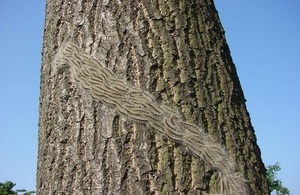Public urged to report Oak Processionary Moth caterpillar sightings
People in London and the South East of England urged to report sightings of Oak Processionary Moth (OPM) caterpillars.

Oak Processionary Moth caterpillars travelling in nose-to-tail procession on tree trunk.
People in London and the South East of England are being reminded to report sightings of Oak Processionary Moth (OPM) caterpillars, which could be damaging oak trees in their area.
Any sightings should be reported to the Forestry Commission via its Tree Alert online form. Alternatively, people can email opm@forestrycommission.gov.uk or call 0300 067 4442.
The Forestry Commission, councils and land managers have an annual programme in place to tackle the pest, which affects certain part of the country in the Spring.
How to identify OPM
Nests are typically dome or teardrop-shaped, averaging the size of a tennis ball. They are white when fresh, but soon become discoloured and brown. The caterpillars have black heads and bodies covered in long white hairs which contain proteins which can cause itchy rashes, eye, and throat irritations. They can also occasionally cause breathing difficulties in people and pets, so should not be touched under any circumstances.
The greatest risk period is May to July when the caterpillars’ emerge and feed before pupating into adult moths, but nests should not be touched at any time. The caterpillars feed on oak leaves, which can leave the trees vulnerable to other pests and diseases and drought.
Craig Harrison, the Forestry Commission’s South-East England Director, said:
The public and those working in green spaces such as tree surgeons and gardeners can help by reporting any suspected OPM sightings.
However, they should not touch the caterpillars or nests themselves; removal is most safely done by specially trained and equipped pest control experts.
Dr Deborah Turbitt, London Deputy Director for Health Protection for Public Health England, endorsed the ‘don’t touch’ advice, saying:
We strongly advise people not to touch or approach the caterpillars or their nests because of the health risks posed by the hairs. Pets and livestock can also be affected and should be kept away as well. The Forestry Commission website has pictures to help identify the pest.
People should see a pharmacist for relief from milder skin or eye irritations following possible OPM contact, or consult a GP or NHS111 for more-serious reactions. Contact a vet if animals are seriously affected.
Anyone pruning or felling oak trees in the affected areas should contact Forestry Commission England’s Tree Health Unit beforehand opm@forestrycommission.gov.uk or 0300 067 4442 for advice about safe removal of the material.
Further information is available from the Forestry Commission website and advice about stings and bites is available on the NHS website.